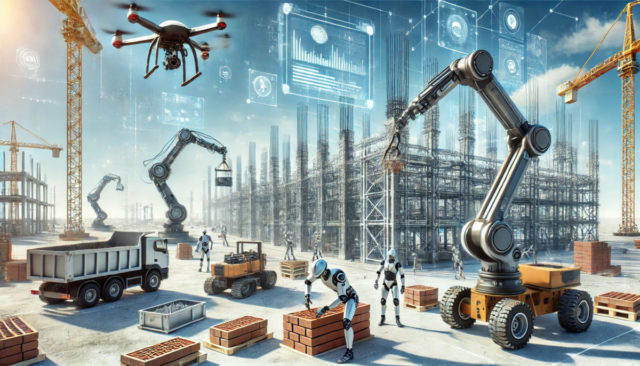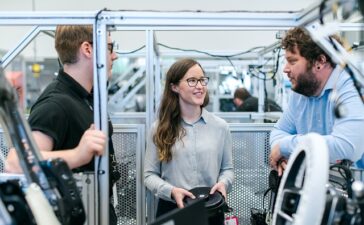Technology in the 21st century is developing at an extraordinary pace. We see changes in everyday life at every turn. The construction industry is one of the economic sectors that is taking full advantage of technological innovations. It will certainly be the same in 2025.
Housing and infrastructure construction is growing rapidly all over the world. To a large extent, it is precisely thanks to new technological solutions. What directions will the construction industry take from a technological point of view? How will inventions and technical innovations be implemented and used in the near future? These and many other questions will be answered in this article. Discover with us the most important technological trends in the construction industry in 2025. We invite you to read on!
Advancements in building information modelling (BIM).
Evolution of BIM by 2025
While BIM is currently an integral part of modern construction, significant development is anticipated by 2025. Notably, BIM technology will integrate even more data, enabling the creation of comprehensive digital models of structures. This advancement will allow designers and contractors to manage the construction process more effectively at every stage.
Integration with AI and machine learning
The fusion of BIM with artificial intelligence (AI) and machine learning will unlock new possibilities in analysing and optimising construction processes. Presently, AI assists in detecting clashes in projects, but in the future, it will also predict potential problems based on historical data analysis. This proactive approach will enhance risk management and efficiency.
Cloud collaboration and real-time data sharing
Cloud-based collaboration is set to become standard in the construction industry. Project teams will be able to work on the same BIM model in real time, regardless of their location. This facilitates quicker responses to changes and updates, which is vital in a dynamic project environment.
Impact on design and construction processes
The utilisation of advanced BIM will significantly optimise design and construction processes. Designers will find it easier to coordinate work across different disciplines, and contractors will better plan schedules and logistics. Undoubtedly, this will contribute to cost reduction and a shorter investment realisation time.
Increasing precision and reducing errors
Detailed BIM models enable a significant increase in precision during planning and execution. Automatic detection of clashes and inconsistencies allows for the elimination of errors at the design stage. This minimises the risk of costly corrections during construction.
Facilitating communication among stakeholders
BIM serves as a platform for effective communication among all participants in the construction process. Investors, designers, contractors, and suppliers have access to up-to-date information, facilitating decision-making and coordination. Therefore, it is an invaluable tool in managing complex construction projects.
Internet of Things (IoT) in construction infrastructure
Integration of devices and systems
Modern construction increasingly utilises IoT technology to integrate various devices and systems within buildings. Connecting elements such as lighting, heating, security systems, and electrical devices creates an intelligent environment that enhances user comfort and energy efficiency.
Sensors monitoring building conditions
Sensors embedded in building structures enable continuous monitoring of technical conditions. They collect data on structural loads, humidity, temperature, and potential damages. Analysing this information allows for early detection of potential problems and prevents more serious failures.
Automation of building functions
Automation allows for remote and integrated management of various building functions. Systems can regulate lighting and temperature based on occupancy, time of day, or weather conditions, increasing comfort and contributing to energy savings.
Safety and maintenance
IoT integration significantly improves safety in buildings. Real-time management of video monitoring systems, alarms, and access control enhances security. Remote access to data and systems also allows for more efficient planning and execution of maintenance processes.
Predictive maintenance of infrastructure
Using sensor data and analysis algorithms enables predictive maintenance of infrastructure. By analysing trends and usage patterns, it’s possible to predict when maintenance or replacement is needed, preventing failures and optimising costs.
Responding to threats in real time
IoT systems enable immediate responses to threats such as fires, gas leaks, or break-ins. Quick action increases user safety and minimises potential damages.
Artificial Intelligence (AI) and data analysis
Optimisation of construction processes
Artificial intelligence is introducing revolutionary changes in optimising construction processes. Currently, AI algorithms can analyse vast amounts of data, allowing for more efficient project planning and management. This capability enables the prediction of potential delays, risk identification, and resource utilisation optimisation.
Predictive modelling and planning
AI-based predictive modelling allows for accurate forecasts regarding various project aspects. By analysing historical and current data, these systems can predict how different factors will affect schedules and budgets. This approach facilitates proactive decision-making and risk minimisation.
Supply chain management
AI streamlines supply chain management by optimising logistical processes. Real-time data analysis enables better planning of material deliveries, avoidance of delays, and reduction of storage costs. This translates into more efficient resource use and increased competitiveness for construction firms.
Personalisation of projects
AI enables the creation of more personalised projects tailored to individual user needs. By analysing the preferences and behaviours of future residents or building users, designers can better meet their expectations. This leads to creating spaces that are more functional and user-friendly.
Adapting buildings to user needs
Intelligent systems based on AI allow buildings to dynamically adapt to changing user requirements. For example, energy management systems can optimise consumption based on current load and resident preferences. This not only increases comfort but also contributes to energy savings.
Intelligent building management systems
Modern AI technologies introduce intelligent building management systems (BMS) that integrate various installations and devices. Central control of lighting, heating, ventilation, and security becomes possible. Simultaneously, these systems learn from user behaviours, allowing for further optimisation and increased energy efficiency.
Sustainable construction. Materials and green building
Innovative building materials
The construction industry is witnessing growing interest in innovative materials aimed at minimising environmental impact. The use of such materials not only promotes environmental protection but can also bring long-term economic benefits.
Biocomposites and renewable materials
Biocomposites are composite materials composed of natural raw materials like plant fibres or biopolymers. Their use contributes to reducing greenhouse gas emissions and limiting the consumption of non-renewable resources. Simultaneously, renewable materials such as certified wood or cellulose fibre insulation are gaining popularity among architects and engineers.
Advantages of biocomposites:
- Biodegradability and recyclability
- Low weight while maintaining strength
- Excellent thermal and acoustic properties
Technological advancements allow for creating new material blends that combine the benefits of natural and synthetic resources, opening new possibilities in design and project implementation.
Self-Healing concrete
Self-healing concrete is an innovative solution utilising the material’s ability to automatically regenerate micro-cracks. Technologies such as adding bacteria, resin capsules, or polymer fibres activate the repair process upon contact with water.
Benefits of Self-healing concrete:
- Extended lifespan of structures
- Reduced maintenance and repair costs
- Increased resistance to corrosion and environmental factors
Implementing this material can significantly lower operating costs of buildings and positively impact sustainable development by reducing the need for frequent renovations.
Energy-saving technologies
With growing ecological awareness, energy-saving technologies are becoming integral to modern construction. They enable not only lower operating costs but also reduce negative environmental impact.
Systems for obtaining renewable energy
Systems like photovoltaic panels, solar collectors, and heat pumps are increasingly integrated into construction projects. Their use enables partial or complete independence from traditional energy sources.
Advantages of renewable energy use:
- Lower energy bills
- Reduced carbon dioxide emissions
- Increased property value
Investments in such solutions may also be supported by grants and tax reliefs, enhancing their attractiveness.
Intelligent energy management systems
Intelligent energy management systems (EMS) are advanced technologies enabling optimal energy use within a building. By utilising sensors, AI algorithms, and automation, these systems adjust energy consumption to current user needs.
Functions of EMS:
- Real-time energy consumption monitoring
- Automatic control of lighting, heating, and air conditioning
- Integration with renewable energy systems
These systems can inform users about further optimisation possibilities, promoting conscious resource usage. Implementing EMS aligns with technological trends in construction, promoting energy efficiency and user comfort.
Virtual and Augmented Reality (VR/AR)
Design and visualisation
VR and AR are revolutionising design processes in the construction industry. These technologies allow for the creation of immersive 3D models, enabling detailed analysis of every project aspect, from spatial layouts to construction details.
Early identification of potential design errors is possible with VR/AR, allowing for corrections before construction begins and resulting in time and cost savings.
Facilitating client decision-making
VR/AR technology offers clients virtual tours of proposed developments. This interactive presentation aids in understanding architectural concepts and spatial functionalities. Clients can provide immediate feedback, expediting decisions and enhancing satisfaction.
Visualising different project variants in VR/AR allows for better customisation to individual investor needs.
Training employees in VR/AR environments
VR/AR technologies are invaluable tools for employee training, simulating various on-site scenarios for practical preparation.
Benefits of VR/AR training:
- Safe environment for learning complex procedures
- Ability to repeat scenarios multiple times
- Reduced costs compared to traditional training
This approach increases training efficiency and enhances team competencies.
Planning and project management
VR/AR supports planning and project management on an unprecedented scale. Virtual visualisation improves coordination among teams and helps predict potential problems.
Simulations of construction stages
Simulations in VR/AR enable precise planning of construction stages. Logistics, equipment placement, and work sequences can be more effectively analysed, contributing to schedule optimisation and delay reduction.
Identifying potential problems before work begins
VR/AR technologies allow for early detection of clashes and inconsistencies, avoiding costly corrections and downtime during projects.
Applications in problem identification:
- Compliance analysis of technical installations
- Verification of ergonomics and space accessibility
- Assessment of environmental impacts on structures
Early problem identification increases efficiency and quality in project execution.
Robotization and automation on construction sites
The integration of robotics and automation is rapidly becoming a cornerstone of modern construction sites. The use of drones and robots significantly enhances both the efficiency and safety of ongoing projects. Drones facilitate rapid and precise collection of terrain data, enabling the creation of accurate 3D models and mapping of work areas. Simultaneously, construction robots are taking over repetitive and demanding tasks, relieving workers and minimizing the risk of errors.
Monitoring progress and safety inspections
Real-time monitoring of construction progress is made possible through drones, which provide up-to-date information instantly. High-quality images and videos allow project management to quickly identify potential delays or issues. Additionally, drones are instrumental in inspecting hard-to-reach areas, increasing worker safety by eliminating the need for risky activities. This technology also enables safety inspections to be conducted to the highest standards, minimizing the risk of accidents.
Construction robots performing repetitive tasks
Robotics in construction focuses on automating monotonous tasks that require high precision. Examples include bricklaying robots that can lay bricks with unprecedented accuracy and speed. Similarly, welding robots are utilised in steel constructions, ensuring uniform weld quality and accelerating the pace of work. Undoubtedly, the use of robots leads to increased productivity and reduced costs associated with human errors.
3D printing in construction
3D printing technology is revolutionising the approach to building and structural creation. It is now possible to print entire structural elements directly on the construction site, opening new possibilities in design and execution. Concurrently, 3D printing allows for the creation of complex forms and structures that would be difficult or impossible to achieve using traditional methods.
Faster construction of structures and components
Employing 3D printing significantly reduces the time required to produce building components. In reality, some elements can be manufactured within a few hours instead of days or weeks. Additionally, this technology enables on-demand production, eliminating the need to store large quantities of materials.
Reduction of material waste
Automation and 3D printing contribute to minimising waste through precise material dosing. Undoubtedly, this leads to a more sustainable approach in construction, crucial in the context of current ecological challenges. Similarly, waste reduction translates into lower costs associated with disposal and raw material purchases.
Cybersecurity in the era of construction digitisation
Data and system protection
As the construction industry digitises, protecting data and systems becomes a priority. Advanced IT technologies bring risks related to information security. Ensuring data integrity, confidentiality, and availability is essential for business continuity.
Protection against hacker attacks
Hacker attacks can cause significant financial and reputational damage. Implementing advanced security measures like firewalls, intrusion detection systems, and data encryption is necessary. Regular software updates and system monitoring help minimise risks.
Secure storage of project information
Project information is valuable and sensitive. Secure storage requires advanced data protection methods, including encryption and regular backups. While cloud computing is popular, choosing providers that guarantee high security standards is crucial.
Standards and regulations
Adhering to standards and regulations like ISO/IEC 27001 and GDPR is vital for cybersecurity. Implementing these frameworks establishes legal and procedural guidelines for data protection, increasing trust among clients and partners.
Implementation of digital security standards
Implementing security standards involves audits and risk assessments. Developing security policies and incident response procedures based on collected information is essential. Investing in identity and access management tools helps control user permissions.
Employee education on cybersecurity
Human error is often the greatest security threat. Educating employees on cybersecurity minimises risks. Training should cover recognising phishing attempts, secure password practices, and guidelines for using mobile devices at work.
Summary – technology trends in construction in 2025
Technological advancements by 2025 are set to revolutionise the construction industry, transforming how projects are designed, executed, and managed. The integration of robotics, AI, sustainable materials, IoT, and VR/AR will enhance efficiency, safety, and environmental responsibility. Embracing these innovations not only improves project outcomes but also contributes to a more sustainable and connected world.
Innovations and the latest technological trends in the construction industry in 2025 will continue to develop in the directions in which they developed rapidly in 2024. They will undoubtedly significantly accelerate construction processes and investments worldwide. After all, it is technological innovations that have underpinned the most important buildings and structures on every continent since the dawn of time. Will there be any other trends and technical solutions in 2025 not covered in our article? Perhaps yes. Innovators and inventors and R&D have always had the ability to surprise us. The same may be true this time. More similar articles can be found at cpcs-training-courses.co.uk






